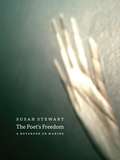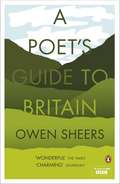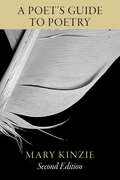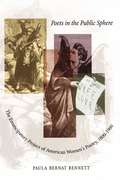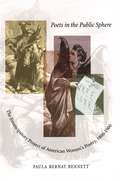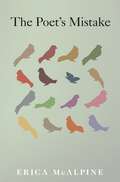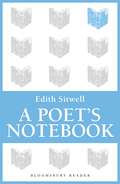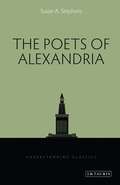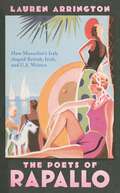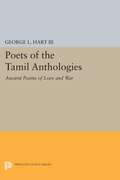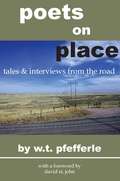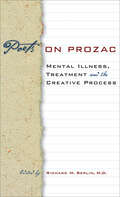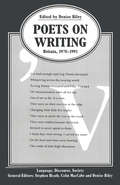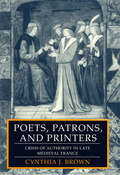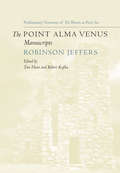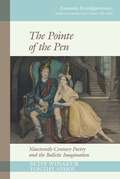- Table View
- List View
The Poet's Freedom: A Notebook on Making
by Susan StewartWhy do we need new art? How free is the artist in making? And why is the artist, and particularly the poet, a figure of freedom in Western culture? The MacArthur Award–winning poet and critic Susan Stewart ponders these questions in The Poet’s Freedom. Through a series of evocative essays, she not only argues that freedom is necessary to making and is itself something made, but also shows how artists give rules to their practices and model a self-determination that might serve in other spheres of work. Stewart traces the ideas of freedom and making through insightful readings of an array of Western philosophers and poets—Plato, Homer, Marx, Heidegger, Arendt, Dante, and Coleridge are among her key sources. She begins by considering the theme of making in the Hebrew Scriptures, examining their accountof a god who creates the world and leaves humans free to rearrange and reform the materials of nature. She goes on to follow the force of moods, sounds, rhythms, images, metrical rules, rhetorical traditions, the traps of the passions, and the nature of language in the cycle of making and remaking. Throughout the book she weaves the insight that the freedom to reverse any act of artistic making is as essential as the freedom to create. A book about the pleasures of making and thinking as means of life, The Poet’s Freedom explores and celebrates the freedom of artists who, working under finite conditions, make considered choices and shape surprising consequences. This engaging and beautifully written notebook on making will attract anyone interested in the creation of art and literature.
The Poet's Freedom: A Notebook on Making
by Susan StewartWhy do we need new art? How free is the artist in making? And why is the artist, and particularly the poet, a figure of freedom in Western culture? The MacArthur Award–winning poet and critic Susan Stewart ponders these questions in The Poet’s Freedom. Through a series of evocative essays, she not only argues that freedom is necessary to making and is itself something made, but also shows how artists give rules to their practices and model a self-determination that might serve in other spheres of work. Stewart traces the ideas of freedom and making through insightful readings of an array of Western philosophers and poets—Plato, Homer, Marx, Heidegger, Arendt, Dante, and Coleridge are among her key sources. She begins by considering the theme of making in the Hebrew Scriptures, examining their accountof a god who creates the world and leaves humans free to rearrange and reform the materials of nature. She goes on to follow the force of moods, sounds, rhythms, images, metrical rules, rhetorical traditions, the traps of the passions, and the nature of language in the cycle of making and remaking. Throughout the book she weaves the insight that the freedom to reverse any act of artistic making is as essential as the freedom to create. A book about the pleasures of making and thinking as means of life, The Poet’s Freedom explores and celebrates the freedom of artists who, working under finite conditions, make considered choices and shape surprising consequences. This engaging and beautifully written notebook on making will attract anyone interested in the creation of art and literature.
The Poet's Freedom: A Notebook on Making
by Susan StewartWhy do we need new art? How free is the artist in making? And why is the artist, and particularly the poet, a figure of freedom in Western culture? The MacArthur Award–winning poet and critic Susan Stewart ponders these questions in The Poet’s Freedom. Through a series of evocative essays, she not only argues that freedom is necessary to making and is itself something made, but also shows how artists give rules to their practices and model a self-determination that might serve in other spheres of work. Stewart traces the ideas of freedom and making through insightful readings of an array of Western philosophers and poets—Plato, Homer, Marx, Heidegger, Arendt, Dante, and Coleridge are among her key sources. She begins by considering the theme of making in the Hebrew Scriptures, examining their accountof a god who creates the world and leaves humans free to rearrange and reform the materials of nature. She goes on to follow the force of moods, sounds, rhythms, images, metrical rules, rhetorical traditions, the traps of the passions, and the nature of language in the cycle of making and remaking. Throughout the book she weaves the insight that the freedom to reverse any act of artistic making is as essential as the freedom to create. A book about the pleasures of making and thinking as means of life, The Poet’s Freedom explores and celebrates the freedom of artists who, working under finite conditions, make considered choices and shape surprising consequences. This engaging and beautifully written notebook on making will attract anyone interested in the creation of art and literature.
The Poet's Freedom: A Notebook on Making
by Susan StewartWhy do we need new art? How free is the artist in making? And why is the artist, and particularly the poet, a figure of freedom in Western culture? The MacArthur Award–winning poet and critic Susan Stewart ponders these questions in The Poet’s Freedom. Through a series of evocative essays, she not only argues that freedom is necessary to making and is itself something made, but also shows how artists give rules to their practices and model a self-determination that might serve in other spheres of work. Stewart traces the ideas of freedom and making through insightful readings of an array of Western philosophers and poets—Plato, Homer, Marx, Heidegger, Arendt, Dante, and Coleridge are among her key sources. She begins by considering the theme of making in the Hebrew Scriptures, examining their accountof a god who creates the world and leaves humans free to rearrange and reform the materials of nature. She goes on to follow the force of moods, sounds, rhythms, images, metrical rules, rhetorical traditions, the traps of the passions, and the nature of language in the cycle of making and remaking. Throughout the book she weaves the insight that the freedom to reverse any act of artistic making is as essential as the freedom to create. A book about the pleasures of making and thinking as means of life, The Poet’s Freedom explores and celebrates the freedom of artists who, working under finite conditions, make considered choices and shape surprising consequences. This engaging and beautifully written notebook on making will attract anyone interested in the creation of art and literature.
The Poet's Freedom: A Notebook on Making
by Susan StewartWhy do we need new art? How free is the artist in making? And why is the artist, and particularly the poet, a figure of freedom in Western culture? The MacArthur Award–winning poet and critic Susan Stewart ponders these questions in The Poet’s Freedom. Through a series of evocative essays, she not only argues that freedom is necessary to making and is itself something made, but also shows how artists give rules to their practices and model a self-determination that might serve in other spheres of work. Stewart traces the ideas of freedom and making through insightful readings of an array of Western philosophers and poets—Plato, Homer, Marx, Heidegger, Arendt, Dante, and Coleridge are among her key sources. She begins by considering the theme of making in the Hebrew Scriptures, examining their accountof a god who creates the world and leaves humans free to rearrange and reform the materials of nature. She goes on to follow the force of moods, sounds, rhythms, images, metrical rules, rhetorical traditions, the traps of the passions, and the nature of language in the cycle of making and remaking. Throughout the book she weaves the insight that the freedom to reverse any act of artistic making is as essential as the freedom to create. A book about the pleasures of making and thinking as means of life, The Poet’s Freedom explores and celebrates the freedom of artists who, working under finite conditions, make considered choices and shape surprising consequences. This engaging and beautifully written notebook on making will attract anyone interested in the creation of art and literature.
The Poet's Freedom: A Notebook on Making
by Susan StewartWhy do we need new art? How free is the artist in making? And why is the artist, and particularly the poet, a figure of freedom in Western culture? The MacArthur Award–winning poet and critic Susan Stewart ponders these questions in The Poet’s Freedom. Through a series of evocative essays, she not only argues that freedom is necessary to making and is itself something made, but also shows how artists give rules to their practices and model a self-determination that might serve in other spheres of work. Stewart traces the ideas of freedom and making through insightful readings of an array of Western philosophers and poets—Plato, Homer, Marx, Heidegger, Arendt, Dante, and Coleridge are among her key sources. She begins by considering the theme of making in the Hebrew Scriptures, examining their accountof a god who creates the world and leaves humans free to rearrange and reform the materials of nature. She goes on to follow the force of moods, sounds, rhythms, images, metrical rules, rhetorical traditions, the traps of the passions, and the nature of language in the cycle of making and remaking. Throughout the book she weaves the insight that the freedom to reverse any act of artistic making is as essential as the freedom to create. A book about the pleasures of making and thinking as means of life, The Poet’s Freedom explores and celebrates the freedom of artists who, working under finite conditions, make considered choices and shape surprising consequences. This engaging and beautifully written notebook on making will attract anyone interested in the creation of art and literature.
A Poet's Guide to Britain
by Owen SheersIntroduced and selected by the poet-presenter Owen Sheers, A Poet's Guide to Britain is a major poetry anthology that ties in with the BBC series of the same name.Owen Sheers passionately believes that poems, and particularly poems of place, not only affect us as individuals, but can have the power to mark and define a collective experience - our identities, our country, our land. He has chosen six powerful poems, all personal favourites, and all poems that have become part of the way we see our landscape. The anthology follows a similar format to the BBC series itself, while also offering paper chains of poems about the landscape and nature of Britain, transcripts of contemporary poet interviews, and a short introduction to each lead poem.
A Poet's Guide to Poetry, Second Edition (Chicago Guides to Writing, Editing, and Publishing)
by Mary KinzieIn A Poet’s Guide to Poetry, Mary Kinzie brings her decades of expertise as poet, critic, and director of the creative writing program at Northwestern University to bear in a comprehensive reference work for any writer wishing to better understand poetry. Detailing the formal concepts of poetry and methods of poetic analysis, she shows how the craft of writing can guide the art of reading poems. Using examples from the major traditions of lyric and meditative poetry in English from the medieval period to the present, Kinzie considers the sounds and rhythms of poetry along with the ideas and thought-units within poems. Kinzie also shares her own successful classroom tactics that encourage readers to approach a poem as if it were provisional. The three parts of A Poet’s Guide to Poetry lead the reader through a carefully planned introduction to the ways we understand poetry. The first section provides careful, step-by-step instruction to familiarize students with the formal elements of poems, from the most obvious feature through the most subtle. The second part carefully examines meter and rhythm, as well as providing a theoretical and practical overview of free verse. The final section offers helpful chapters on writing in form. Rounding out the volume are writing exercises for beginning and advanced writers, a dictionary of poetic terms, and a bibliography of further reading. For this new edition, Kinzie has carefully reworked the introductory material and first chapter, as well as amended the annotated bibliography to include the most recent works of criticism. The updated guide also contains revised exercises and adjustments throughout the text to make the work as lucid and accessible as possible.
Poets in the Public Sphere: The Emancipatory Project of American Women's Poetry, 1800-1900
by Paula Bernat BennettBased entirely on archival research, Poets in the Public Sphere traces the emergence of the "New Woman" by examining poetry published by American women in newspapers and magazines between 1800 and 1900. Using sources like the Kentucky Reporter, the Cherokee Phoenix, the Cincinnati Israelite, and the Atlantic Monthly, Bennett is able to track how U.S. women from every race, class, caste, region, and religion exploited the freedom offered by the nation's periodical press, especially the poetry columns, to engage in heated debate with each other and with men over matters of mutual concern. Far from restricting their poems to the domestic and personal, these women addressed a significant array of political issues--abolition, Indian removals, economic and racial injustice, the Civil War, and, not least, their own changing status as civil subjects. Overflowing with a wealth of heretofore untapped information, their poems demonstrate conclusively that "ordinary" nineteenth-century women were far more influenced by the women's rights movement than historians have allowed. In showing how these women turned the sentimental and ideologically saturated conventions of the period's verse to their own ends, Bennett argues passionately and persuasively for poetry's power as cultural and political discourse. As much women's history as literary history, this book invites readers to rethink not only the role that nineteenth-century women played in their own emancipation but the role that poetry plays in cultural life.
Poets in the Public Sphere: The Emancipatory Project of American Women's Poetry, 1800-1900
by Paula Bernat BennettBased entirely on archival research, Poets in the Public Sphere traces the emergence of the "New Woman" by examining poetry published by American women in newspapers and magazines between 1800 and 1900. Using sources like the Kentucky Reporter, the Cherokee Phoenix, the Cincinnati Israelite, and the Atlantic Monthly, Bennett is able to track how U.S. women from every race, class, caste, region, and religion exploited the freedom offered by the nation's periodical press, especially the poetry columns, to engage in heated debate with each other and with men over matters of mutual concern. Far from restricting their poems to the domestic and personal, these women addressed a significant array of political issues--abolition, Indian removals, economic and racial injustice, the Civil War, and, not least, their own changing status as civil subjects. Overflowing with a wealth of heretofore untapped information, their poems demonstrate conclusively that "ordinary" nineteenth-century women were far more influenced by the women's rights movement than historians have allowed. In showing how these women turned the sentimental and ideologically saturated conventions of the period's verse to their own ends, Bennett argues passionately and persuasively for poetry's power as cultural and political discourse. As much women's history as literary history, this book invites readers to rethink not only the role that nineteenth-century women played in their own emancipation but the role that poetry plays in cultural life.
Poets in the Public Sphere: The Emancipatory Project of American Women's Poetry, 1800-1900
by Paula Bernat BennettBased entirely on archival research, Poets in the Public Sphere traces the emergence of the "New Woman" by examining poetry published by American women in newspapers and magazines between 1800 and 1900. Using sources like the Kentucky Reporter, the Cherokee Phoenix, the Cincinnati Israelite, and the Atlantic Monthly, Bennett is able to track how U.S. women from every race, class, caste, region, and religion exploited the freedom offered by the nation's periodical press, especially the poetry columns, to engage in heated debate with each other and with men over matters of mutual concern. Far from restricting their poems to the domestic and personal, these women addressed a significant array of political issues--abolition, Indian removals, economic and racial injustice, the Civil War, and, not least, their own changing status as civil subjects. Overflowing with a wealth of heretofore untapped information, their poems demonstrate conclusively that "ordinary" nineteenth-century women were far more influenced by the women's rights movement than historians have allowed. In showing how these women turned the sentimental and ideologically saturated conventions of the period's verse to their own ends, Bennett argues passionately and persuasively for poetry's power as cultural and political discourse. As much women's history as literary history, this book invites readers to rethink not only the role that nineteenth-century women played in their own emancipation but the role that poetry plays in cultural life.
The Poet's Mistake
by Erica McAlpineWhat our tendency to justify the mistakes in poems reveals about our faith in poetry—and about how we readKeats mixed up Cortez and Balboa. Heaney misremembered the name of one of Wordsworth's lakes. Poetry—even by the greats—is rife with mistakes. In The Poet's Mistake, critic and poet Erica McAlpine gathers together for the first time numerous instances of these errors, from well-known historical gaffes to never-before-noticed grammatical incongruities, misspellings, and solecisms. But unlike the many critics and other readers who consider such errors felicitous or essential to the work itself, she makes a compelling case for calling a mistake a mistake, arguing that denying the possibility of error does a disservice to poets and their poems.Tracing the temptation to justify poets' errors from Aristotle through Freud, McAlpine demonstrates that the study of poetry's mistakes is also a study of critical attitudes toward mistakes, which are usually too generous—and often at the expense of the poet's intentions. Through remarkable close readings of Wordsworth, Keats, Browning, Clare, Dickinson, Crane, Bishop, Heaney, Ashbery, and others, The Poet's Mistake shows that errors are an inevitable part of poetry's making and that our responses to them reveal a great deal about our faith in poetry—and about how we read.
The Poet's Mistake
by Erica McAlpineWhat our tendency to justify the mistakes in poems reveals about our faith in poetry—and about how we readKeats mixed up Cortez and Balboa. Heaney misremembered the name of one of Wordsworth's lakes. Poetry—even by the greats—is rife with mistakes. In The Poet's Mistake, critic and poet Erica McAlpine gathers together for the first time numerous instances of these errors, from well-known historical gaffes to never-before-noticed grammatical incongruities, misspellings, and solecisms. But unlike the many critics and other readers who consider such errors felicitous or essential to the work itself, she makes a compelling case for calling a mistake a mistake, arguing that denying the possibility of error does a disservice to poets and their poems.Tracing the temptation to justify poets' errors from Aristotle through Freud, McAlpine demonstrates that the study of poetry's mistakes is also a study of critical attitudes toward mistakes, which are usually too generous—and often at the expense of the poet's intentions. Through remarkable close readings of Wordsworth, Keats, Browning, Clare, Dickinson, Crane, Bishop, Heaney, Ashbery, and others, The Poet's Mistake shows that errors are an inevitable part of poetry's making and that our responses to them reveal a great deal about our faith in poetry—and about how we read.
A Poet's Notebook
by Edith SitwellFirst published in 1943, this is a selection of writings from Dr. Sitwell's private notebooks. It includes essays on prosody, the role of the poet, the nature of poetry, and includes her full length work 'A Notebook on William Shakespeare', as well as discussion of Chaucer, Herrick, Wordsworth, Pope and Byron amongst others.The section on Shakespeare consists of essays on the general aspect of the plays - those great hymns to the principle and the glory of life. There are long essays on King Lear, Macbeth, Othello, and Hamlet. Miss Sitwell believes, with all humility, that she has discovered new sources of the inspiration of King Lear, throwing a new light on the whole play , and giving us new meaning to the mad scenes, of an unsurpassable grandeur, depth and terror. There are essays on many of the comedies, and long passages about the Fools and Clowns, all of which serve to illiminate Shakespeare's mighty and many-sided genius.
The Poets of Alexandria (Understanding Classics Ser.)
by Susan A. StephensAlexandria was the greatest of the new cities founded by Alexander the Great as his armies swept eastward. It was ruled by his successors, the Ptolemies, who presided over one of the richest and most productive periods in the whole of Greek literature. Susan A Stephens here reveals a cultural world in transition: reverential of the compositions of the past (especially after construction of the great library, repository for all previous Greek oeuvres), but at the same time forward-looking and experimental, willing to make use of previous forms of writing in exciting new ways. The author examines Alexandria's poets in turn. She discusses the strikingly avant-garde Aetia of Callimachus; the idealized pastoral forms of Theocritus (which anticipated the invention of fiction); and the neo-Homerian epic of Apollonius, the Argonautica, with its impressive combination of narrative grandeur and psychological acuity. She shows that all three poets were innovators, even while they looked to the past for inspiration: drawing upon Homer, Hesiod, Pindar and the lyric poets, they emphasized stories and material that were entirely relevant to their own progressive cosmopolitan environment.
The Poets of Rapallo: How Mussolini's Italy shaped British, Irish, and U.S. Writers
by Lauren ArringtonA new story about the relationships between major twentieth-century English-language poets. Why did poets from the United States, Britain, and Ireland gather in a small town in Italy during the early years of Mussolini's regime? These writers were—or became—some of the most famous poets of the twentieth century. What brought them together, and what did they hope to achieve? The Poets of Rapallo is about the conversations, collaborations, and disagreements among Ezra and Dorothy Pound, W.B. and George Yeats, Richard Aldington and Brigit Patmore, Thomas MacGreevy, Louis Zukofsky, and Basil Bunting. Drawing on their correspondence, diaries, drafts of poems, sketches, and photographs, this book shows how the backdrop of the Italian fascist regime is essential to their writing about their home countries and their ideas about modern art and poetry. It also explores their interconnectedness as poets and shows how these connections were erased as their work was polished for publication. Focusing on the years between 1928 and 1935, when Pound and Yeats hosted an array of visiting writers, this book shows how the literary culture of Rapallo forged the lifelong friendships of Richard Aldington and Thomas MacGreevy—both veterans of the First World War—and of Louis Zukofsky and Basil Bunting, who imagined a new kind of "democratic" poetry for the twentieth century. In the wake of the Second World War, these four poets all downplayed their relationship to Ezra Pound and avoided discussing how important Rapallo was to their development as poets. But how did these "democratic" poets respond to the fascist context in which they worked during their time in Rapallo? The Poets of Rapallo discusses their collaboration with Pound, their awareness of the rising tide of fascism, and even—in some cases—their complicity in the activities of the fascist regime. The Poets of Rapallo charts the new direction for modernist writing that these writers imagined, and in the process, it exposes the dark underbelly of some of the most lauded poetry in the English language.
The Poets of Rapallo: How Mussolini's Italy shaped British, Irish, and U.S. Writers
by Lauren ArringtonA new story about the relationships between major twentieth-century English-language poets. Why did poets from the United States, Britain, and Ireland gather in a small town in Italy during the early years of Mussolini's regime? These writers were—or became—some of the most famous poets of the twentieth century. What brought them together, and what did they hope to achieve? The Poets of Rapallo is about the conversations, collaborations, and disagreements among Ezra and Dorothy Pound, W.B. and George Yeats, Richard Aldington and Brigit Patmore, Thomas MacGreevy, Louis Zukofsky, and Basil Bunting. Drawing on their correspondence, diaries, drafts of poems, sketches, and photographs, this book shows how the backdrop of the Italian fascist regime is essential to their writing about their home countries and their ideas about modern art and poetry. It also explores their interconnectedness as poets and shows how these connections were erased as their work was polished for publication. Focusing on the years between 1928 and 1935, when Pound and Yeats hosted an array of visiting writers, this book shows how the literary culture of Rapallo forged the lifelong friendships of Richard Aldington and Thomas MacGreevy—both veterans of the First World War—and of Louis Zukofsky and Basil Bunting, who imagined a new kind of "democratic" poetry for the twentieth century. In the wake of the Second World War, these four poets all downplayed their relationship to Ezra Pound and avoided discussing how important Rapallo was to their development as poets. But how did these "democratic" poets respond to the fascist context in which they worked during their time in Rapallo? The Poets of Rapallo discusses their collaboration with Pound, their awareness of the rising tide of fascism, and even—in some cases—their complicity in the activities of the fascist regime. The Poets of Rapallo charts the new direction for modernist writing that these writers imagined, and in the process, it exposes the dark underbelly of some of the most lauded poetry in the English language.
Poets of the Tamil Anthologies: Ancient Poems of Love and War
by George L. Hart IIIThe poems of ancient Tamil are one of India's most important contributions to world literature. Presented here in English translation is a selection of roughly three hundred poems from five of the earliest poetic anthologies of classical Tamil literature. These lyrical poems are intimately related to the agricultural society that produced them, and their direct connection with the earth as well as their use of ornament and suggestion give them a quality unlike that of any other poetic tradition.Originally published in 1979.The Princeton Legacy Library uses the latest print-on-demand technology to again make available previously out-of-print books from the distinguished backlist of Princeton University Press. These editions preserve the original texts of these important books while presenting them in durable paperback and hardcover editions. The goal of the Princeton Legacy Library is to vastly increase access to the rich scholarly heritage found in the thousands of books published by Princeton University Press since its founding in 1905.
Poets On Place: Tales And Interviews From The Road
by W. T. PfefferleOut to see America and satisfy his travel bug, W. T. Pfefferle resigned from his position as director of the writing program at Johns Hopkins University and hit the road to interview sixty-two poets about the significance of place in their work. The lively conversations that resulted may surprise with the potential meanings of a seemingly simple concept. This gathering of voices and ideas is illustrated with photo and word portraits from the road and represented with suitable poems. The poets are James Harms, David Citino, Martha Collins, Linda Gregerson, Richard Tillinghast, Orlando Ricardo Menes, Mark Strand, Karen Volkman, Lisa Samuels, Marvin Bell, Michael Dennis Browne, David Allan Evans, David Romtvedt, Sandra Alcosser, Robert Wrigley, Nance Van Winckel, Christopher Howell, Mark Halperin, Jana Harris, Sam Hamill, Barbara Drake, Floyd Skloot, Ralph Angel, Carol Muske-Dukes, David St. John, Sharon Bryan, Donald Revell, Claudia Keelan, Alberto Rios, Richard Shelton, Jane Miller, William Wenthe, Naomi Shihab Nye, Peter Cooley, Miller Williams, Beth Ann Fennelly, Natasha Trethewey, Denise Duhamel, Campbell McGrath, Terrance Hayes, Alan Shapiro, Nikki Giovanni, Charles Wright, Rita Dove, Henry Taylor, Dave Smith, Nicole Cooley, David Lehman, Lucie Brock-Broido, Michael S. Harper, C. D. Wright, Mark Wunderlich, James Cummins, Frederick Smock, Mark Jarman, Carl Phillips, Scott Cairns, Elizabeth Dodd, Jonathan Holden, Bin Ramke, Kenneth Brewer, and Paisley Rekdal.
Poets on Prozac: Mental Illness, Treatment, and the Creative Process
by Richard M. BerlinPoets on Prozac shatters the notion that madness fuels creativity by giving voice to contemporary poets who have battled myriad psychiatric disorders, including depression, schizophrenia, post-traumatic stress disorder, and substance abuse.The sixteen essays collected here address many provocative questions: Does emotional distress inspire great work? Is artistry enhanced or diminished by mental illness? What effect does substance abuse have on esthetic vision? Do psychoactive medications impinge on ingenuity? Can treatment enhance inherent talents, or does relieving emotional pain shut off the creative process?Featuring examples of each contributor’s poetry before, during, and after treatment, this original and thoughtful collection finally puts to rest the idea that a tortured soul is one’s finest muse.
Poets on Writing: Britain, 1970–1991 (Language, Discourse, Society)
by Denise RileyA collection of essays and some related poems by almost 30 contemporary poets who have worked for years outside the "mainstream" of British publishing. Many are or have been small-press publishers and editors too.
Poets, Patrons, and Printers: Crisis of Authority in Late Medieval France
by Cynthia J. BrownCynthia J. Brown explains why the advent of print in the late medieval period brought about changes in relationships among poets, patrons, and printers which led to a new conception of authorship.Examining such paratextual elements of manuscripts as title pages, colophons, and illustrations as well as such literary strategies as experimentation with narrative voice, Brown traces authors' attempts to underscore their narrative presence in their works and to displace patrons from their role as sponsors and protectors of the book. Her accounts of the struggles of poets, including Jean Lemaire, Jean Bouchet, Jean Molinet, and Pierre Gringore, over the design, printing, and sale of their books demonstrate how authors secured the status of literary proprietor during the transition from the culture of script and courtly patronage to that of print capitalism.
Poets Thinking: Pope, Whitman, Dickinson, Yeats
by Helen VendlerPoetry has often been considered an irrational genre, more expressive than logical, more meditative than given to coherent argument. And yet, in each of the four very different poets she considers here, Helen Vendler reveals a style of thinking in operation; although they may prefer different means, she argues, all poets of any value are thinkers. The four poets taken up in this volume--Alexander Pope, Walt Whitman, Emily Dickinson, and William Butler Yeats--come from three centuries and three nations, and their styles of thinking are characteristically idiosyncratic. Vendler shows us Pope performing as a satiric miniaturizer, remaking in verse the form of the essay, Whitman writing as a poet of repetitive insistence for whom thinking must be followed by rethinking, Dickinson experimenting with plot to characterize life's unfolding, and Yeats thinking in images, using montage in lieu of argument. With customary lucidity and spirit, Vendler traces through these poets' lines to find evidence of thought in lyric, the silent stylistic measures representing changes of mind, the condensed power of poetic thinking. Her work argues against the reduction of poetry to its (frequently well-worn) themes and demonstrates, instead, that there is always in admirable poetry a strenuous process of thinking, evident in an evolving style--however ancient the theme--that is powerful and original.
The Point Alma Venus Manuscripts
by Robinson JeffersThe years 1921 to 1927 were the most productive of Robinson Jeffers's career. During this period, he wrote not only many of his most well-known lyric poems but also Tamar, The Tower Beyond Tragedy, Roan Stallion, and The Women at Point Sur—the long poems that first established his reputation as a major American poet. Including an introduction, chronology, and critical afterword, the Point Alma Venus manuscripts presented here gather Jeffers's four unfinished but substantial preliminary attempts at what became The Women at Point Sur, which Jeffers believed was the "most inclusive, and poetically the most intense" of his narrative poems. The Point Alma Venus fragments and versions shed important light on the composition and themes of The Women at Point Sur. Further, they likely predate other key work from this crucial period, making them a necessary context for those who wish to clarify Jeffers's poetic development and to reinterpret his practice of narrative poetry. Ultimately, they call on general and scholarly readers alike to reconsider Jeffers's place in the canon of modern American poetry.
The Pointe of the Pen: Nineteenth-Century Poetry and the Balletic Imagination (Romantic Reconfigurations: Studies in Literature and Culture 1780-1850 #15)
by Betsy TontiplapholOriginally a courtly art, ballet experienced dramatic evolution (but never, significantly, the prospect of extinction) as attitudes toward courtliness itself shifted in the aftermath of the French Revolution. As a result, it afforded a valuable model to poets who, like Wordsworth and his successors, aspired to make the traditionally codified, formal, and, to some degree, aristocratic art of poetry compatible with “the very language of men” and, therefore, relevant to a new class of readers. Moreover, as a model, ballet was visible as well as valuable. Dance historians recount the extraordinary popularity of ballet and its practitioners in the nineteenth century, and The Pointe of the Pen challenges literary historians’ assertions – sometimes implicit, sometimes explicit – that writers were immune to the balletomania that shaped both Romantic and Victorian England, as well as Europe more broadly. The book draws on both primary documents (such as dance treatises and performance reviews) and scholarly histories of dance to describe the ways in which ballet's unique culture and aesthetic manifest in the forms, images, and ideologies of significant poems by Wordsworth, Byron, Shelley, and Barrett Browning.
